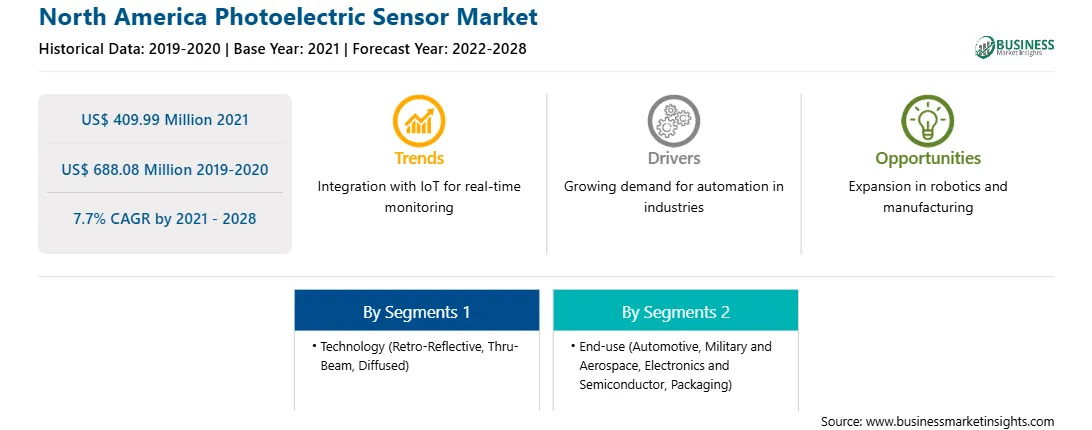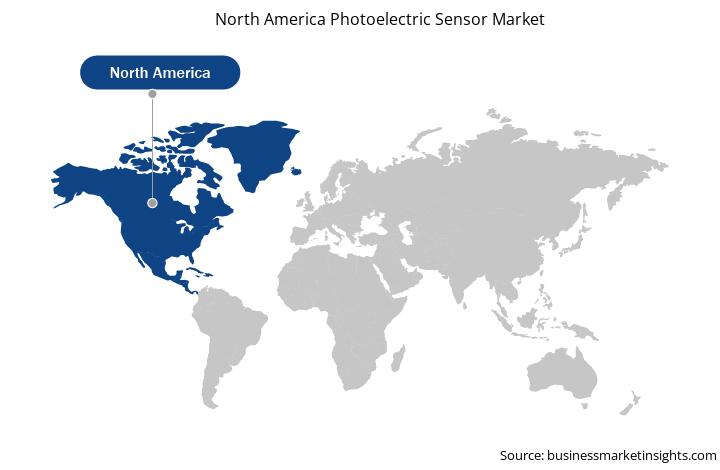The increasing practices of automation and adoption of advanced technology in the manufacturing industries across the North American region is generating the need of photoelectric sensor to increase the quality of products with reduced error in the production process. Further, Investments in innovative lighting technology have also provided a robust industry outlook. For instance, the government of Chicago introduced a plan in October 2019 to replace over 270,000 city lights with LED lights and intelligent lighting systems by 2022, thereby fostering the demand for sensor, including ambient & proximity light sensor. In addition, dependence on robots in industrial controller mechanisms is currently an established trend, which is paving the way for larger and wider adoption of industrial control and industrial automation equipment. This is causing material handling to be one of the fastest-growing application markets for proximity sensor in the region.
North America is one of the leading regions in terms of the development and adoption of new technologies; this is mainly attributed to favorable government policies that boost innovation and strengthen the infrastructure capabilities. Hence, any impact on the growth of industrial sector hampers the economic growth of the region. Presently, the US is the world’s worst-affected country due to COVID-19 outbreak. The industry's reliance on human labour has been highlighted by the recent pause in industrial automation and development. This is expected to showcase the benefits of robotics and automation in the post-lockdown phase, leading to increased adoption. The overall demand for industrial automation components and digitalization is likely to increase once the industries attain normal operational conditions; these technologies are a need of the hour amid high market competition worldwide. Hence, the photoelectric sensor industry is projected to growth at a steady pace in the post-pandemic period.

Strategic insights for the North America Photoelectric Sensor provides data-driven analysis of the industry landscape, including current trends, key players, and regional nuances. These insights offer actionable recommendations, enabling readers to differentiate themselves from competitors by identifying untapped segments or developing unique value propositions. Leveraging data analytics, these insights help industry players anticipate the market shifts, whether investors, manufacturers, or other stakeholders. A future-oriented perspective is essential, helping stakeholders anticipate market shifts and position themselves for long-term success in this dynamic region. Ultimately, effective strategic insights empower readers to make informed decisions that drive profitability and achieve their business objectives within the market.

| Report Attribute | Details |
|---|---|
| Market size in 2021 | US$ 409.99 Million |
| Market Size by 2028 | US$ 688.08 Million |
| CAGR (2021 - 2028) | 7.7% |
| Historical Data | 2019-2020 |
| Forecast period | 2022-2028 |
| Segments Covered |
By Technology
|
| Regions and Countries Covered | North America
|
| Market leaders and key company profiles |
|
The geographic scope of the North America Photoelectric Sensor refers to the specific areas in which a business operates and competes. Understanding local distinctions, such as diverse consumer preferences (e.g., demand for specific plug types or battery backup durations), varying economic conditions, and regulatory environments, is crucial for tailoring strategies to specific markets. Businesses can expand their reach by identifying underserved areas or adapting their offerings to meet local demands. A clear market focus allows for more effective resource allocation, targeted marketing campaigns, and better positioning against local competitors, ultimately driving growth in those targeted areas.

The photoelectric sensor market in North America is expected to grow from US$ 409.99 million in 2021 to US$ 688.08 million by 2028; it is estimated to grow at a CAGR of 7.7% from 2021 to 2028. Pharmaceutical companies focus on improving their overall manufacturing operations by avoiding discrepancies such as empty packaging, which can be caused due to the unavailability of medicine tablets on the production line. The industry is increasingly deploying photoelectric sensor for tablet counting, bottle filling, and count verification (in clinical trials). These sensor are also being used in automated prescription fulfillment machines at retail pharmacies and hospitals. Further, Advancements in photoelectric sensor in terms of their sensing range, which is improving their counting accuracy, along with maintaining a hygienic production environments by excluding human contacts while packaging of medicine are the benefits associated with photoelectric sensor. Also, photoelectric sensor provides a cost effective solutions which is attained through automatic production line to pharmaceutical industry. Hence, the surge in the adoption of photoelectric sensor in pharmaceutical companies is mainly attributed to their abilities to enhance efficiencies, reduce industry’s operational costs, and facilitate real-time production monitoring. These sensor automate the upper and lower levels of liquid measurement in jar or tank. The use of strong corrosive chemicals (acidic or basic) is commonplace in pharmaceutical companies, and thus, the detection of liquid levels in storage tanks is an important task in these plants. Thus, increasing use of photoelectric sensor in the pharmaceuticals industry would drive the photoelectric sensor market growth in the coming years.
In terms of technology, the retro-reflective segment accounted for the largest share of the North America photoelectric sensor market in 2020. Further In term of end-use, the automotive segment held a larger market share of the photoelectric sensor market in 2020.
A few major primary and secondary sources referred to for preparing this report on the photoelectric sensor market in North America are company websites, annual reports, financial reports, national government documents, and statistical database, among others. Major companies listed in the report are Autonics Corporation; Balluff GmbH; Eaton Corporation plc.; ifm electronic GmbH; OMRON Corporation; Rockwell Automation, Inc.; Panasonic Corporation; SICK AG; Schneider Electric SE; and Keyence Corporation among others.
The North America Photoelectric Sensor Market is valued at US$ 409.99 Million in 2021, it is projected to reach US$ 688.08 Million by 2028.
As per our report North America Photoelectric Sensor Market, the market size is valued at US$ 409.99 Million in 2021, projecting it to reach US$ 688.08 Million by 2028. This translates to a CAGR of approximately 7.7% during the forecast period.
The North America Photoelectric Sensor Market report typically cover these key segments-
The historic period, base year, and forecast period can vary slightly depending on the specific market research report. However, for the North America Photoelectric Sensor Market report:
The North America Photoelectric Sensor Market is populated by several key players, each contributing to its growth and innovation. Some of the major players include:
The North America Photoelectric Sensor Market report is valuable for diverse stakeholders, including:
Essentially, anyone involved in or considering involvement in the North America Photoelectric Sensor Market value chain can benefit from the information contained in a comprehensive market report.